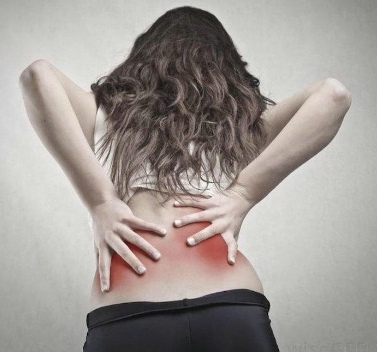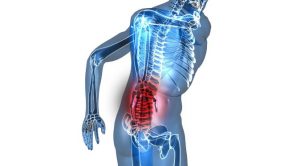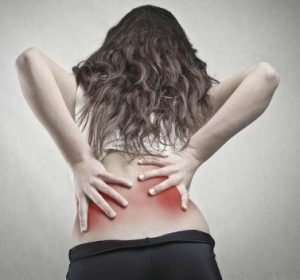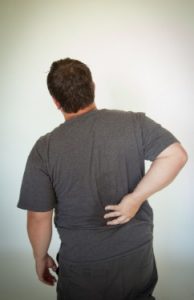One of the worst forms of pain is lower back pain. The back is such an important part of the body that when it hurts, it usually affects everything. It makes sitting, walking, or even laying down hard. Doing something as simple as tying your shoes can become very painful. Suffering from lower right back pain is no exception to this, but is highly specific.
Lower back pain is in some instances felt primarily or entirely on the right side as opposed to being evenly spread across your back. Low back pain might be quite a common complaint, but some people suffer from lower right back pain. Pain in the lower right back is typically experienced in the right side of the lower region of the back. It includes the lumbar, spine, as well as lower spinal vertebrae, parts of the right ride of the spine, and even the hip area that is rested when one is seated. Understanding the probable causes of lower right back pain and the typical characteristics helps lead to a more accurate diagnosis and more effective treatment.
Symptoms of Lower Right Back Pain
Lower right back pain sometimes manifests as a pain in the back’s lower region when you lift weight, bend, engage in a particular activity, or when you travel. Back pain can be associated with pain that radiates from the lower back to the legs, back of thighs, and buttocks. Pain usually radiates from the lower back to the groin in front.
Lower right back pain is sometimes acute back pain, manifesting as a lightning, sharp, or shooting pain, while in some cases it can be a dull aching pain throughout the area. Pain usually lasts for a short period of time if it is acute pain in the lower right back or it can last for much longer, which makes it chronic back pain. Pain in the lower right back sometimes causes weakness and the sufferer is usually unable to bend, stand, or continue with the activity.
Pain in the lower right back is sometimes felt with a stabbing, burning sensation or it can be accompanied with tingling and numbness in the lower limbs. It could be related to a particular activity or could worsen if you make further movements. It could also be associated with sudden jerking movements, a history of falling, accidents, sports injuries, or lifting heavy weights. Back pain can be due to musculoskeletal conditions or could be related to the internal organs.
Severe lower back pain that makes the person unable to move demands immediate medical attention. If lower right back pain is accompanied by loss of control over bower movements, weakness of the lower limbs, it can be categorized as a medical emergency.
Causes of Lower Right Back Pain
Pain in the lower back and especially in the right side can be caused by various different conditions. Recent medical guidelines suggest pains in this region can be divided into three different categories.
- Non-specific pains in the lower back are the most common type of lower back pain. Over 90% of the population has this type of lower back pain.
- This is caused by nerve root irritation and is not as common as category one lower back pains. Less than 5% of the population suffers from this type of discomfort, this is felt less in the left or right of the back and is situated at the top of the legs and buttocks.
- The final type of pain is much less common and only about 1% of the populations will experience this very specific type of back pain.
Different Causes of Lower Right Back Pain
Muscle strain – The most common type of pain to afflict this region is muscle pain. This can be caused by a number of different actions and maintenance errors. If you lift an especially heavy object with your back instead of your knees and legs, you could pull a muscle. Moving in an especially acute angle or without properly preparing your muscles for action is another way to damage these muscles.
Lower Back Muscle spasm – After prolonged bouts of strain and stress the muscles of this region can begin to get very sore. This stress can be created by many different factors from tired overworked muscles to movement that place the muscle in a bad way. Even sitting for prolonged hours with poor posture can cause tension in the lower back. If the joints and muscle of the lower back became especially strained they can tighten up more than usual and this will cause a back spasm. The important erector spinae that runs the length of the spinal column and has an important job of holding the back upright is easily affected in this way.
Sciatica – The sciatic nerve is located in the back of the knees, certain movements and conditions can cause this nerve to become pinched with seriously painful side effects. When this condition develops, the person develops sciatica. The pain from this condition can run the length of the legs to the lower back and inhibit movement. Any sudden movements can cause and acute pain, such as coughing or sneezing. The lack of mobility that accompanies this condition is a signature symptom of sciatica.
Degenerative Disc Disease – there can be many times when the lumbar discs on the back can become problematic as it begins to fall into disrepair. This condition actually begins to affect everyone after the age of 20. As the condition worsens, it is more difficult to move about as these discs have an important role in keeping the body upright. This pain can range from mildly uncomfortable to seriously debilitating depending on the progression. One good thing about this is that there have been many successful treatments for this condition that can improve the discs and mitigate the suffering.
Isthmic Spondylolisthesis – While this condition is typically started in children, the effects will only become apparent after the person reaches the age of 20. This happens when the vertebrae are not properly aligned and begin to fall forward. This is actually a fairly common condition and begins to cause pain in the lower back. It can also begin to add pressure as posture is harder to control this will cause additional pain.
Spinal Compression Fracture – there are other types of pain adults will suffer quite suddenly on their lower back and this can be much more than the regular aches and pains. A spinal fracture can actually be caused by something as seemingly innocuous as a sneeze or cough. The majority of instances occur in bones that have been damaged and weakened by various causes.
Osteomyelitis – This is rare type of infection that can be experienced as an infection of the spine. There are typically more sufferers of this condition in the older than 60 categories but it has happened to people much younger. Those that have spent a lot of time doing harsh drugs can also be prone this type of infection as can those with immune deficiencies.
Herniated Disk – this is likely the most common reason for lower back pains in the right and left side. It could be caused by a sudden movement or even an injury from an accident. Many times, people are suffering from this condition but don’t even know it. While they will go away by themselves sometimes, they can be especially problematic. If you have suddenly lost control of your bowels or you find yourself incapable of moving, the situation has gone serious and you need to see a doctor.
Fractured Spine – You can fracture many parts of your body and they will heal without a problem, but if you have fractured your spine, you could have a very serious condition. This is another injury that can be caused by a sudden movement or a serious to mild accident. Elderly people are more prone to this type of injury than most. The symptoms of a spinal fracture are fairly obvious, if you feel pain with every move you make you could have a fracture and it is imperative to your mobility and life that you find professional medical care fast.
Ulcerative Colitis – This inflammatory bowel disease can cause serious paint throughout the lower back and colon region. Frequent cramping and pain from this condition can cause pains in both sides of the back and this situation can be aggravated with other conditions such as rectal pain and numbness, weight loss, diarrhea and fatigue.
Kidney issues – the kidneys are located right in the lower part of the back on either side is one kidney. If there were to be an infection or pain in your kidney the side that is experiencing pain has a problem. The type of pain can be very acute or a simple dull ache depending on the problem. There are various things that could wrong with the kidneys from blockage to infections and having your condition addressed by a member of the medical profession is the best idea. There are many different treatments to address a great variety of different conditions.
Appendicitis – the appendix is another inner organ that can cause upset and the lower back to begin aching severely, the same is true if the appendix should rupture or begin leaking. Symptoms vary greatly depending on how advanced the condition is, nevertheless, there is also till much to learn about the possible onset of the pain. There is evidence that shows the problem with chronic appendix pain is that it can be most symptomatic in the lower right region of the back. The first symptom is a pain that shoots through the lower abdomen and can be experienced in the back. There is also a large chance that this will be accompanied by sweating, shivers, fever, vomiting and nausea.
Pregnancy – a major cause for severe back pain can be a small life forming in the womb and causing great strain on the muscles of the back both upper and lower. It is quite normal for the muscles ligaments in this region to become stretched and this can add to the suffering. The best way to address this particular type of pain is with hot compresses, lots of extra rest and even a dedicated pregnancy massage that has been known to do wonders for many expecting mothers.
Gynecological disorders – women have their reproductive organs located in the pelvis region and these can cause pain throughout the lower back and abdominal region. Endometriosis is an especially painful condition that can cause shooting pains through the pelvic area and this can be radiated to the lower back on either side. Tissues amasses called fibroids are also a major cause of pains in the lower back as well as abnormal menstruation and severe pain during intercourse.
Sacroiliac Joint problems – while this is particularly rare condition, there is a portion of the population who should be aware of this. This typically affects women who have had children and is often caused by childbirth or the inflammation of diseases like ankylosing spondylitis.
The Management and Treatment of Lower Right Back Pain
If you suffer from lower right back pain or just lower back pain, you can use several different natural methods to manage or treat the pain and possibly even address the cause of the pain. It is important to note that you should first seek the advice of a qualified medical professional if you suffer from lower right back pain or lower back pain for a diagnosis before embarking on treatment.
While the natural treatment approaches discussed here may work for you, it is important to know where the problem lies so that you are able to use the right treatment. Moreover, if it is a condition or disease such as degenerative disc disease or cancer, professional care will be necessary as opposed to treating it yourself.
Resting
Rest might seem like such an obvious remedy, but people sometimes ignore this recommendation given how busy their lives are. Resting the back is the easiest natural remedy for most lower back pain cases. Avoid lifting heavy items/objects for 1 or 2 days and try to limit back movement. Get comfortable and binge watch a TV show or read a book. This allows the muscles in the back to relax and allows the body to repair any damage they might have sustained. However, rest should only be for a day or two at most.
Icing
Icing is best used together with rest and sometimes helps relieve the pain. It helps reduce the flow of blood to the area being iced and reduce the swelling. It also confuses the pain receptors in the back, and dulls the pain while it is recovering. The best approach is to ice in 20-minute sessions. Avoid putting ice packs directly onto skin but rather use a towel to wrap it and avoid being frostbitten.
Heat
Heat helps to loosen tight muscles that could be the cause of your pain. Combining heat with ice works wonders. Try 15 minutes of ice, followed by 15 minutes of heat.
Stretching and Light Workouts
Once you have rested the back for several days, stretching and light workouts can be quite beneficial. It helps loosen up muscles and keep them in working condition. Avoid performing the movements or activities that could have caused the injury. You also need to be careful when performing lower back pain exercises. If the back starts to hurt, stop performing the workout.
The Bottom Line
Lower right back pain can be due to many different causes. Some of the types of pain can be quite severe but is some cases, they are only caused by easily curable conditions. Lower back pain and lower right back pain can be treated using natural methods such as rest, stretching, and ice. However, if there is a chance of it being something beyond a torn or stretched muscle, consult a doctor. Treatment of the less serious issues may involve something as simple as bed rest while the more serious issues may require something as serious as surgery. The moment you realize why you are experiencing back pain is when you will know the most appropriate treatment to cure it.




